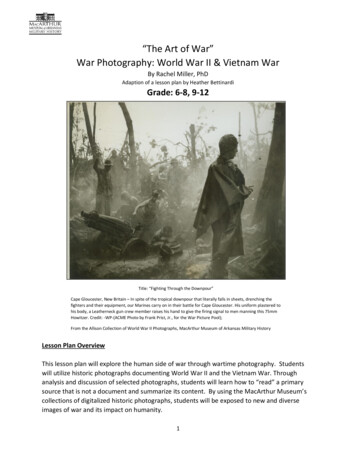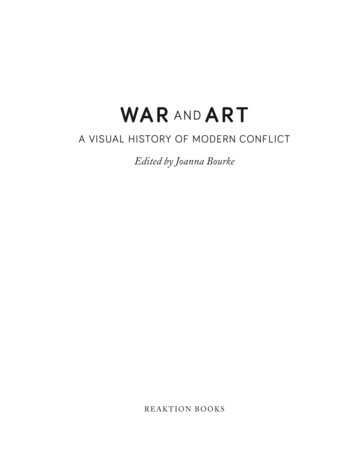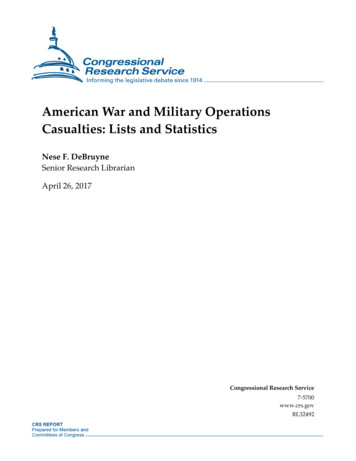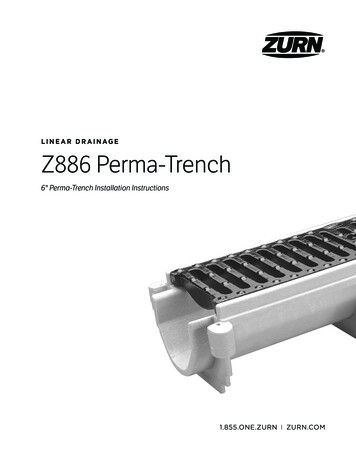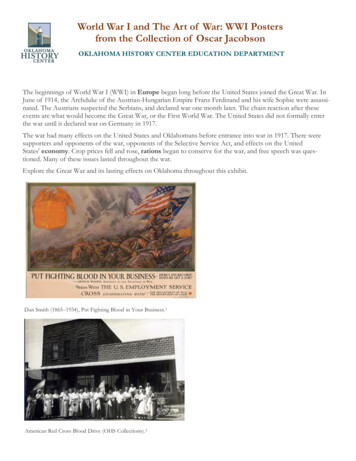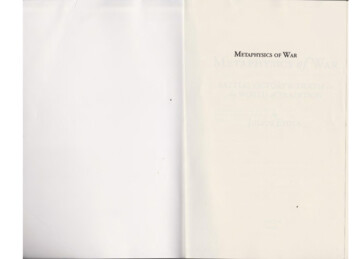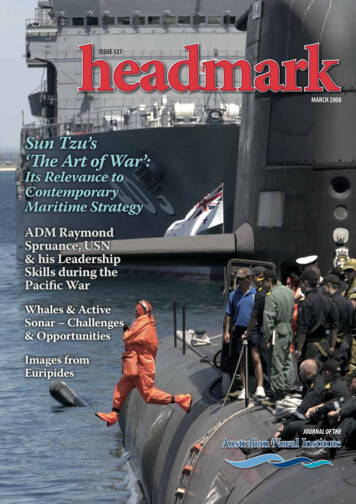
Transcription
“The Art of War”:Trench Art of World War IMartha BohnenbergerSterling SchoolGreenville, South Carolina
Grade Level:6–8Objectives:At the conclusion of this lesson, students will be able to Gain an understanding of the involvement of art in World War I and also how WorldWar I changed the world of art dramaticallyGuiding Question:How do art and warfare impact each other?Connections to Common Core:CCSS.ELA-Literacy.RH.6-8.2 Determine the central ideas or information of a primary orsecondary source; provide an accurate summary of the source distinct from priorknowledge or opinions.CCSS.ELA-Literacy.RH.6-8.7 Integrate visual information (e.g., in charts, graphs,photographs, videos, or maps) with other information in print and digital texts.CCSS.ELA-Literacy.RH.6-8.8 Distinguish among fact, opinion, and reasoned judgment in atext.CCSS.ELA-Literacy.RH.6-8.9 Analyze the relationship between a primary and secondarysource on the same topic.Connections to C3 Framework:D1.5.6-8. Determine the kinds of sources that will be helpful in answering compelling andsupporting questions, taking into consideration multiple points of views represented inthe sources.D2.Civ.14.6-8. Compare historical and contemporary means of changing societies, andpromoting the common good.D2.His.1.6-8. Analyze connections among events and developments in broader historicalcontexts.D2.His.5.6-8. Explain how and why perspectives of people have changed over time.Documents Used:Articles for Teacher Background Knowledge:Reed Johnson, “Art Forever Changed by World War n Veteran’s Health: .pdf2
Donna Kaiser, et al. “Call for Art Therapy Research on Treatment of rg/upload/callforresearchptsd.pdfDiary Entries / Sketches:Albert Earl Robinson- (140th Infantry, 35th Division). Born in Bangor, Maine, Robinsonlived in Boston, but was attending art school in Kansas City. After the war, he worked inthe editorial department of the Kansas City Star for many years. He wrote many featurestories and made many drawings for the Star, some about World War I. He also wroteshort stories and several one-act plays which were published in magazines. One of theseplays, Canvas Arches, won a local theatre prize. His wife published his memoir, An EpicDay, after his death in 1964. Some material from the scanned diary is published in thisbook.www.theworldwar.org/NHDAudio Recording:Henry Williamson, “Description of Christmas Truce,” tem/1237Images and Artifacts included in PowerPoint:“French in Trench”www.theworldwar.org/NHDBohnenberger, Gustave. Photograph, 1915Family collection of the author.Gustave Bohnenberger was born in 1898 in Huchenfeld, Germany. He was in the Germantrenches in Belgium during the Christmas Truce of 1914.Bohnenberger, Gustave. Christmas Card River Pebble, 1914Family collection of the author.Gustave was in the German trenches in Belgium during the Christmas Truce of 1914where he painted this Christmas “card” to his Mother. It is painted on a river pebble withnatural minerals found in the trenches. He was 16 years old at the time.Bohnenberger, Gustave. Photograph collection, 1918-1928Family collection of the author.These family photographs of Gustave Bohnenberger show his wartime service in theBelgian trenches in 1918, as well as Gustave with friends shortly after the end of the war.Shortly after the war, Gustave married his wife Erna, but suffered from PTSD from hisexperiences in the war and therefore he had a very hard time adjusting. Ottmar was bornin 1919. Gustave experienced two failed suicide attempts in 1920 and 1921. In 1922,3
the family moved to the United States in the hope that Gustave would fare better in a newenvironment. Sadly, he committed suicide in 1928, and was found by his son, Ottmar.“Letter Opener Trench /8762/2604This letter opener was made from bullets and scrap metal by Sid Roberts. He was gassedtwice and returned to another regiment, the Engineers. Being gassed saved his life as restof his comrades were all killed.“Candle Holder Trench /8941/3606This candle holder was made from a cut-down 18 pounder shell case, with an addedhandle. The case was manufactured in 1916 and last refilled in November 1917.“Patch Work Cushion Trench 0?CISOBOX 1&REC 1This patchwork cushion contains a birthday wish message. It is decorated with pins,beads, and an Army Service Corps badge, made by F. Thompson while convalescing afterbeing wounded in the feet.Otto Dix, Storm troopers advancing under a gas attack from the portfolio War, -square/world-war-i-and-revolution/“Princess Mary Christmas hese boxes were decorative brass tins sent by Princess Mary to members of the British,Colonial and Indian Armed Forces for Christmas 1914. Over 426,000 of these tins weredistributed to those serving on Christmas Day 1914. The tins were filled with variousitems including tobacco, confectionary, spices, pencils, a Christmas card and a picture ofthe princess.Lesson Description:Overview: Throughout history, the creation of art has been a natural remedy for stress.This lesson will look at World War I as the first modern war as a result of modernweaponry and atrocities. As a result, PTSD (post-traumatic stress disorder) occurred inlarge numbers. However, this stress related disease had not yet become a diagnosis atthat time, but was dubbed “Shell-Shock” and viewed as a “moral deficiency” of someone’scharacter. Most soldiers suffered in silence. The only relief that many soldiers had forthis illness was art, and art in all types was created in the horrific conditions of the4
trenches on the Western Front. Before this lesson is taught, students should have beentaught about trench warfare.Time: This lesson can range from one to five days depending on the depth of knowledgethat the teacher would like the students to acquire.Materials: Albert Robinson letters “Australian Veteran’s Health” article Veterans Health Graphic Organizer PowerPoint file: Art and World War I (includes teacher notes) Primary Source Analysis Sheet Article and discussion questions: “Art Forever Changed by World War I” (foroptional activity)Lesson Preparation: Make one set of Robinson letters for each group of 5-6 students “Australian Veteran’s Health” article – copy 1 set for each group of 5-6 students Make one copy of the veteran’s health graphic organizer and primary sourceanalysis tool per studentDay 1 Procedure: Give each group (5 to 6 students) one copy of each of the Robinson letters, andthe “Australian Veteran’s Health” article. Give each student the Australian veterans health graphic organizer and a cartoonanalysis sheet. They should read the article and letters and fill out the graphicorganizer and cartoon analysis. A class discussion should follow about the horrorsof World War I trench warfare, “shell shock,” how health professionals and thepopulation in general looked at this affliction, and Robinson’s experiences and hisartwork. The following question should then be posed to the class and answered ina paragraph with supporting evidence from the article and letters.o“Why do you think Robinson drew the cartoons on each of his letters?”Day 2 Procedure: The teacher should play the audio recording by Henry Williamson describing theChristmas truce of 1914 for the students. Then the teacher should show the imageof the Princess Mary Christmas Box and pose the following question to thestudents:5
o “How do you think the soldiers in the trenches feelings would differ, if theyreceived a utilitarian box, rather than a beautiful box, filled with the samenecessities?” Using the available PowerPoint file, students should then try and analyze thepictures of Gustave Bohnenberger’s and other soldiers’ artwork that was created inthe trenches during World War I. Ask students to infer the answers.oooo“What was the object originally?”“What was the object made into?”“How they were made in the trenches?”The answers to the questions are in brief summaries in the “notes” sectionof the PowerPoint.Day 3 Procedure (Optional): Depending on the class’ maturity level, the teacher can discuss consequences ofPTSD on Gustave Bohnenberger. Bohnenberger had two attempted suicides in theearly 1920s and committed suicide in 1928. The students will then read the article, “Art Forever Changed by World War I,” byReed Johnson and answer the discussion questions. They will then analyze the painting by Otto Dix, Storm troopers advancing under agas attack from the portfolio War (1924). The following questions should be posedto the students:ooooWhat images are in the painting?What is happening in the painting?What is the artist trying to portray in the painting?How does the painting make you feel when you view it?Assessment Materials: Response to Robinson letters graphic organizers class participation in discussionsMethods for Extension: The main lesson is on day 1. If time permits the lesson can be extended with day2. The lesson can also be extended further by having students do independentresearch about an artist, other than Dix, or another piece of artwork that wasinfluenced by World War I. They would then write a short essay of his/her analysis.6
The student would then record a podcast of his/her analysis which can be postedto share with classmates. The URL of the audio can then be linked to an image ofthe artwork with a QR code (which can be attached to the artwork by printing theQR code and gluing it to an image of the artwork). QR codes can be created veryeasily on a QR website. The students can then have an artwork “walk” where eachstudent uses an IPod or phone to access the QR code and listen to the student’sanalysis of his/her artwork. The artist research could also be done across the curriculum in tandem with an artor language arts teacher.Adaptations: “A picture is worth a thousand words.” This old saying is very true when specialneeds and English Language Learner students are concerned. These students canbenefit from a visual of a concept and will make connections at a more rapid ratewhen more than one modality is used such as auditory and visual.7
Bibliography:Primary SourcesBohnenberger, Gustave. Photographs, 1915-1929. Personal collection of the author.Bohnenberger, Gustave. Christmas Card River Pebble, 1914. Personal collection of theauthor.Dix, Otto. Storm troopers advancing under a gas attack from the portfolio War (1924).Etching, Art Gallery of New South Wales. Accessed February 17, d-square/world-war-i-and-revolution/.“French in Trench (1976.227.30),” Photograph, from the National World War I Museum,Kansas City, Missouri. Accessed February 21, 2014. www.theworldwar.org/NHD.Robinson, Albert E. Diary with Cartoon Sketches (1986.34.8), pages 42-43, 50-57, fromthe National World War I Museum, Kansas City, Missouri. Accessed February 21,2014. www.theworldwar.org/NHD.Williamson, Henry. “Description of Christmas Truce,” December 1914, audio file. The FirstWorld War Poetry Digital s/item/1237.Secondary Sources“Australian Veteran’s Health: WWI.” Medical Association for Prevention of War. AccessedFebruary 7, 2014. Candle Holder Trench Art.” Photograph, from The First World War Poetry Digital Archive,University of Oxford. Accessed February 17, 8941/3606.Johnson, Reed. “Art Forever Changed by World War I.” Los Angeles Times, (July 21, 2012).Accessed February 7, tainment/la-et-cm-world-war-art20120722Kaiser, Donna, et al. “Call for Art Therapy Research on Treatment of PTSD.” American ArtTherapy Association. Last modified 2005. Accessed February 7, upload/callforresearchptsd.pdf“Letter Opener Trench Art.” Photograph, from The First World War Poetry Digital Archive,University of Oxford. Accessed February 17, 2014.8
2604.“Patch Work Cushion Trench Art.” Photograph, from The First World War Poetry DigitalArchive, University of Oxford. Accessed February 17, ?CISOBOX 1&REC 1.“Tin – Princess Mary’s Christmas Gift, 1914.” Museum Victoria. Accessed February 7,2014. 9146/tin-princessmary-s-christmas-gift-1914.9
2/18/2014French in Trench1914-1918:Art andWorld War IPhotograph courtesy of World War I Museum“From the fiction of Hemingway to thesavagely critical paintings of Otto Dix,WWI reshaped the notion of art, just asit forever altered the perception of war.” -By Reed JohnsonLos Angeles Times; July 21, 2012“Art therapists have reported remarkable resultsfrom work with combat veterans, traumatizedchildren and survivors of major disastersincluding the 9/11 terrorist attacks. Theoristshave identified psychological and neurologicalmechanisms that most likely are operating in arttherapy indicating it has unique capacities topromote recovery from PTSD.”-Call for Art Therapy Research on Treatment of PTSD2005 American Art Therapy Association, Inc.Life in the Trenches Australian Veteran’s Health: WWI article Albert E. Robinson Letters and cartoons1
2/18/20141914TheChristmasTruceAudio Description of theChristmas Truce Henry, Williamson; Description ofChristmas Truce, 1914. In 1914 he was a private in the LondonRegt, and later served as officer with 208thCoy Machine Gun Corps in GB. This is adescription of a conversation with Germanofficer and on Western Front, duringChristmas truce, 12/19142
2/18/2014Princess Mary Christmas BoxGustave BohnenbergerBelgium Trenches 1914Why do you think he took the time andeffort to paint a rock?What do you think the rock says?Who do you think the rock was intendedfor?“How do you think the soldiers in the trenches feelings would differ, about receiving abeautiful box, rather than a utilitarian box, filled with the same necessities?”In Germany after the war,early 1920sIn theUnited States19273
2/18/2014What was it originally? What is it now?How was it made?What was it originally? What is it now?How was it made?What was it originally? What is it now?How was it made?Art Forever Changed byWorld War I By Reed Johnson; LA Times; July 21, 2012War is something so animal-like: hunger, lice, slime, these crazy sounds War was something horrible, but nonetheless something powerful Underno circumstances could I miss it! It is necessary to see people in thisunfettered condition in order to know something about them.-Otto Dix4
NameAustralian Veteran’s Health: World War I Graphic OrganizerFill out the chart below with information from the article: Australian Veteran’s Health: WWIHealth IssuesSummary and effects on soldiersPercentage ofPopulation who wereSoldiersInjuries and DeathsPhysical Wounds andTreatmentDisease in theTrenchesChemical WarfarePsychological TraumaAnswer the following questions:1. How was psychological trauma looked at by medical professionals and how did they treat thecondition?2. How did Albert E. Robinson describe life in the trenches in the letter?
NameCartoon Analysis SheetDescribe what you see.What do you notice first?What people and objects are shown?What, if any, words do you see?What other details can you see?What's happening in the cartoon?What tools were used to create this?What do you see that looks different than it would in a photograph?What was happening when this cartoon was made?Who do you think was the audience for this cartoon?
NameDiscussion Questions: Art Forever Changed by World War IWhat causality did the art world have as a result of World War I?What is Modernism as described by the author?List three writers who emerged from World War I.List three painters who emerged from World War I.What was Morpurgo’s quote about how the British people felt about World War I?What two fields of art arose from World War I?According to the author, what was the war’s most enduring legacy?
Gain an understanding of the involvement of art in World War I and also how World War I changed the world of art dramatically Guiding Question: How do art and warfare impact each other? Connections to Common Core: CCSS.ELA-Literacy.RH.6-8.2 Determine the central ideas or information of a primary or


